Calming Strategies for Children: Techniques to Teach to Children
It’s no secret that children feel a lot of big feelings. Our children with emotional regulation issues (such as those with autism, ADHD, anxiety, anger issues, etc.) may feel those feelings even more intensely than other children.
And they also may struggle with knowing how to calm down or get those feelings back into check. This often leads to outbursts, behavioral challenges, and interpersonal issues. Check out our tools and resources for helping children regulate their emotions and calm themselves down as needed.
How to Teach a Child to Use Calming Strategies and Techniques:
Self-Calming Strategies for Children
As much as you hate to see it in your own child, every child throws tantrums and has meltdowns, sometimes in the middle of the grocery store. This can be even more prevalent if your child has a language delay and doesn’t understand or can’t communicate what he wants. Your job as a parent or teacher is not to prevent the child from ever getting upset. We’ve seen those kids, we call them “spoiled” and they have a long road ahead of them because they aren’t always going to get their way.
Instead, your job is to teach your child how to deal with getting upset. In particular, it can be extremely helpful to teach your child calming strategies to calm himself or herself down. There are many calming strategies that you can teach your child to get through those awful meltdowns faster and without requiring you to bribe your child with ice cream and toys to make it stop.
This process may take a while, especially if you have a child who can really let it rip, but have patience and keep working on it. It will get better. Calming children with self-calming strategies has worked for children across the world, and it can work for your child, too!
1. Make Sure the Old Behaviors Don’t Work
If you try to teach your child these calming strategies but you eventually give in after he’s been screaming for 5 minutes (even if you only give in sometimes), the calming strategies won’t be as effective as throwing that tantrum so the tantrums will never stop and the calming strategies will never work. I know this can be so hard to do because you don’t want to see your child hurting and you don’t want to cause a scene in whatever public place you may happen to be, but this is crucial. If your child starts throwing a fit about something, don’t give in, even if you were just about to change your mind anyway. Your child will feel like the tantrum worked to get him what he wanted and the next tantrum will be even bigger. Here’s what you should do at this point if your child is melting down:
- Remain calm, don’t show any emotion to your child. If you have to walk away so you can compose yourself, do that. If you need to tag in your spouse to handle the problem because you’re too emotional, do that.
- Try to wait the tantrum out for a bit. See if it goes away on its own if you don’t give it much attention. Just monitor your child for safety and make sure that your child doesn’t put himself in any dangerous situations (like throwing a tantrum in the knife aisle at Bed, Bath, and Beyond). If he does, calmly move him away from danger without making a big deal out of it.
- Remove your child from the situation. Carry him out of the store (if you can do so safely) or back to his room. Try to isolate him from any attention he may get for the tantrum.
- Wait till it passes. Because it will. Eventually, your child will tire and that’s when he will need a hug. Be there with his hug when he’s ready for it and have faith that the rest of these steps will make these tantrums better. (But again, don’t give in to what he wanted, even after the tantrum stops).
2. Identifying Calm Vs. Upset
The first thing you need to do is teach your child the difference between being calm and being upset. You will want to do this with your child when she is calm. I like to use a mood thermometer for this. A mood thermometer has a happy face at the bottom, an angry face at the top, and sometimes a few faces in between indicating someone who is on their way up or down the continuum.
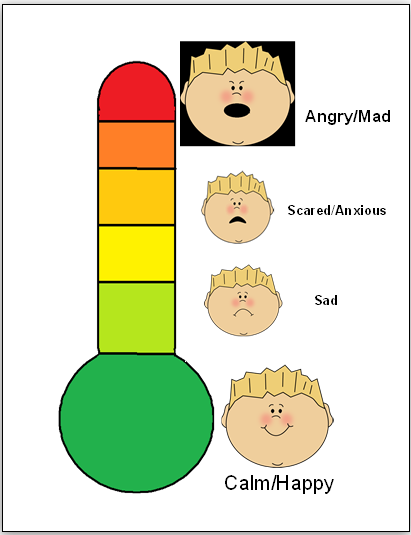
Show your child the thermometer and say “when we are happy and calm, we are down here at the bottom”. Explain to your child that she is calm right now and show her where she is. You can even show her pictures of other children who are calm and happy. Then, tell her that when we are not happy, we are the top of the thermometer. We are upset. Show her pictures of children who are upset. You can type “child tantrum” into Google image search and get some pretty great upset children. Have her help you figure out which children look calm and which children look upset.
You can also talk about some emotions in between, such as sad or scared. These often will lead to being upset if not dealt with early. Those will be the best times to try some calming strategies with your child. Keep working on labeling these emotions until your child is starting to understand them. You can even label her own emotions when you see them. For example, if your child is starting to get upset, show her the thermometer and say “You look sad” while pointing to the sad face.
Just help her understand what those emotions look like and how they feel. I’ve even had some parents take pictures of their children displaying different emotions and use those to show their children. Be creative and talk about emotions a lot. Once your child starts to understand, move on to step three.
3. Teaching Calming Strategies when Calm
Think about your child when he’s in the middle of a tantrum. Do you think now would be a good time to teach him a new skill? Probably not, I’m guessing he wouldn’t be listening very well at that point. So the best time to teach calming strategies is while your child is already calm. It sounds counter-productive but we’ll get to the actual calming part later. Try a whole bunch of calming strategies with your child and see which ones he seems to do well with or he seems to like the most.
Keep trying them until you get about four that your child can do fairly well. It helps if each strategy has its own picture to go with it so your child can learn what they are. You can create your own pictures (like take pictures of the child doing the strategy) or you can use the ones I’ve created:
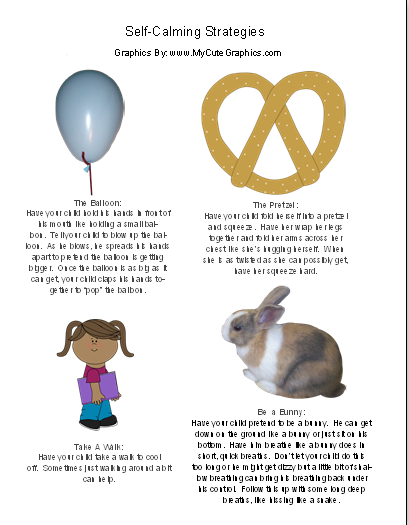
Here are some strategies to try with your child. Show him how to do each one and then have him do it with you. After you’ve practiced them several times, have your child do them by himself so you can see which ones he’s learning the best. This will help you pick your four.
- The Balloon: Have your child hold his hands in front of his mouth like holding a small balloon. Tell your child to blow up the balloon. As he blows, he spreads his hands apart to pretend the balloon is getting bigger. Once the balloon is as big as it can get, your child claps his hands together to “pop” the balloon.
- The Pretzel: Have your child fold herself into a pretzel and squeeze. Have her wrap her legs together and fold her arms across her chest like she’s hugging herself. When she is as twisted as she can possibly get, have her squeeze hard.
- Take a Walk: Have your child take a walk to cool off. Sometimes just walking around a bit can help.
- The Bunny: Have your child pretend to be a bunny. He can get down on the ground like a bunny or just sit on his bottom. Have him breathe like a bunny does in short, quick breaths. Don’t let your child do this too long or he might get dizzy but a little bit of shallow breathing can bring his breathing back under his control. Follow this up with some long deep breaths, like hissing like a snake or blowing out candles.
- Write a Letter: Have your child “write a letter” about why she’s mad. Get out a piece of paper and a big fat crayon. Have your child scribble violently all over the paper. This should release some tension. If your child is older, you may actually be able to get her to write down why she’s mad. When she’s done, have your child read it to you or just crumple the paper and throw it away. If this strategy works for your child, you can have a calm-down bucket or stash that has paper and a crayon just for such an occasion.
- Count or Sing the ABCs: Have your child count as high as he can or sing/say the alphabet. Many times this is enough to bring the breathing back under control to quell the tantrum.
- Hug a Pillow/Stuffed Animal: Have your child pick a pillow or stuffed animal to hug. Tell her to squeeze it hard so she can get all of that upset out. She could also tell her stuffed animal why she’s upset.
4. Make a Calming Strategies Board and Practice
Choose the four strategies that work best for your child (and feel free to use your own if you know of something that works for your child) and put them together on a board. It’s best if you get some sturdy poster board for this as it may be thrown across the room in anger at first. Cut out the pictures from my printout or make your own and put the four pictures (with descriptions) on the board. You should also put the mood thermometer on the board so you can use it to show your child. While your child is still calm, show her the board and say “this is what we will use when we are upset. When your body is red (point to the red on the thermometer) and you are upset, we will use these calming strategies to make your body green and help you calm down.”
Have your child practice each of the calming strategies while she’s calm so you know she can do them. You could also pretend to be upset at some point and go over to the board to show her how to use it. Role playing is great for young children and those with language delays. You can also create a smaller version of this board to stick in your purse in case you need it on the go.
5. Practice the Calming Strategies When Your Child is Upset
Now that your child knows the strategies, it’s time to put them into action. The next time your child starts to get upset, try to catch it before he gets completely out of control mad. Say “Your body doesn’t look green, let’s get our calming board”. Bring him the calming board and show him where he is on the thermometer. Label his emotion for him by saying “You are upset” or “you are mad”. Then, ask him to pick a calming strategy to try.
If you’re lucky, he’ll remember his training and pick a strategy so you can help him through it. More likely though, he will be so mad about it that he will refuse to choose and possibly even try to cause harm to your board. Remain calm, this too will pass. If he doesn’t want to pick a strategy, you pick one for him and demonstrate it. Don’t force him to do it with you. Then, wait a minute or two and try that whole process again. Eventually, he should calm down enough to be able to do a strategy. However, the first several times you try this, it may take a while, especially if he’s just now getting used to you not giving in to his tantrums.
Just keep trying it every few minutes until he’s ready to do one with you. If you stay calm, that will bring him down even faster. Eventually, your child should be more willing to do this. If you do it consistently with him, he will get to the point where you can say, “You look like you need to calm down, why don’t you go pick a strategy. When your body is green again, we can talk (or I can give you a hug)”. Then, he should be able to go calm himself down using the strategies you have practiced so many times. Keep in mind it may be a long way down the road before he can do this on his own, but that’s the overall goal. Once your child is calmed after a tantrum, talk with your child calmly about what happened and what you can do to solve the problem. Now is the time to work through the problem, now that he’s calm.
Keep calm and be persistent and you can teach your child these calming strategies as well. Be sure to use the social media buttons below to share this post with your friends and family so others can benefit from this info on calming children as well!

About the Author: Carrie Clark, MA CCC-SLP
Hi, I’m Carrie! I’m a speech-language pathologist from Columbia, Missouri, USA. I’ve worked with children and teenagers of all ages in schools, preschools, and even my own private practice. I love digging through the research on speech and language topics and breaking it down into step-by-step plans for my followers.
Connect with Me:

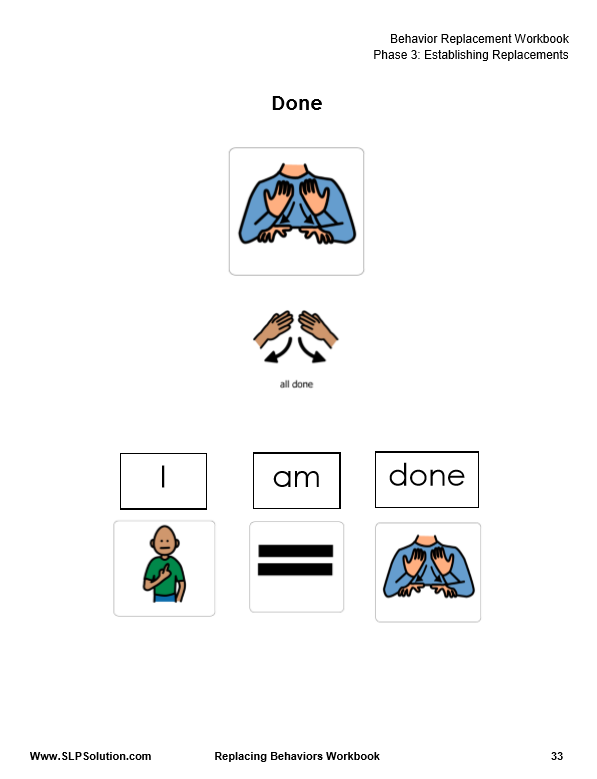
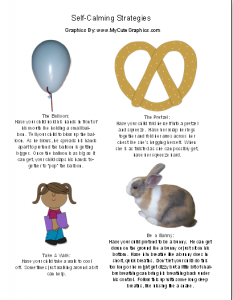
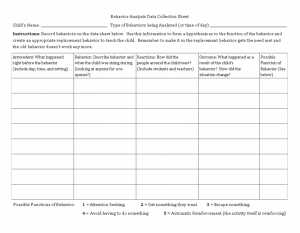
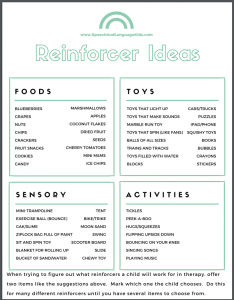


What a wonderful handout to parents!!
Have a few I would share it with.
Thank You!!
Great! I hope it can help them!!
Thanks Carrie! These are great ideas and visuals.
You’re welcome! Glad you enjoyed it!
Thank you! Just when I needed it!
Great! Glad it’s helped!
I can’t wait to share this with a few parents and preschool teachers!! Thank you so much for putting all this together!
No problem! I’m glad you know people who will benefit from it!
Definitely worth passing on to moms and dads….or anyone else working with young ones! Teaching a child self regulation strategies is the best gift you can give and it can last a lifetime!
I agree! Thanks for reading and commenting!!
Thanks for the great visual supports Carrie. As an early childhood special education teacher, I work with kiddos with mod/severe Autism. And I think these will be really helpful in the classroom and for parents-THANKS!
No problem! Make sure to check out my autism resource page as well:
Autism Resource Page:
http://www.speechandlanguagekids.com/autism-resource-page/
This is great! Though I have a rebellious twelve-year old and I wonder if there are other strategies for that.
It depends on if your 12-yr-old is being rebellious because there is a sensory need that is not being met or if it’s for some other reason. Good luck figuring it out!
This is all excellent advice because most children do not even have the words to express how they are feeling nor are they aware that they are reacting to a feeling. Self-control can get them through many social situations.
Speaking from experience, a child’s feelings or meltdowns are sometimes just as hard on the parents.
I completely agree!
i am so in love with this website. thanks carrie for sharing us the theories of whys and concentrating on the how-tos and what-to-dos that help me so much to understand and know what to do whenever a meltdown strikes. helps me lot!
Hi Carrie, this is a great way to explain things! I really like how you focused on empowering the parent!
I’m and OT working 30+ years and always looking for updated resources. I am personally studying social relationships with my kiddos which of course encompasses speech, lang., communication skills.
I work with birth to three population the most (have older kids too) but the problem with many websites explaining sensory and behavioral responses of children is that while the information is good, there are often references to Autism, behavioral disorders, sensory processing disorders etc. While many of my kiddos are waiting to be diagnosed, I want families have info. that doesn’t make them cry, worry or not sleep at night, which sometimes happens as a result of reading about these disorders. I found it hopeful! Thank you!
Thank you for the great tips! It can be overwhelming when you’re trying to find help for your child and every website wants to diagnose them with out giving the parent the tools to help deal with whatever problem the child may have. I feel as though I can help my child when she has a tantrum and also with her stuttering while I’m waiting for an appoitment with her physician. I don’t feel so helpless and alone because its hard watching her trying to express herself and she is having a hard time getting it out.
I am a parent of a child in the spectrum from India. It would be great if you can help me with picture cards of verbs and adjective games, sequencing, CVC, CVCV words. Thank you
Hi, Shweta-We have sent you an email with the requested materials.
Hello!
I was wondering how I can approach this with the parents off the child I care for without alarming them, or appearing to be critical. They notice it too, the child is almost two. He repeats the last word said, sometimes it’s cute, but I have never noticed this before from all the children I have cared for .
Hello, Donna – Thank you so much for reaching out. Unfortunately, we get a ton of questions every day about how to solve specific speech/language problems. Since we have such a small staff, we aren’t able to answer every question that comes through on the website, social media, or via email. If you are a parent, we suggest you reach out to a local speech-language pathologist who can work with your child directly and answer your question.
If you are another speech-language professional, we have created a membership where we pay a full staff to answer questions like this on a regular basis. We would be more than happy to answer your question inside the membership program. We’re able to answer more questions in here because we have a full library of questions that we’ve already answered so our staff can either link you to the answer if it exists, or write you a custom response if needed. We’d love to see you inside the membership!
Click Here to Become a Member: https://www.slpsolution.com/pediatric-signup/
hello! Do you mind emailing this resource to me please? thank you so much!
Hi, Shoma-We have emailed you the requested materials. Please let us know if you need anything else.
A tantrum is not a meltdown though. Autistic children and other neurodiverse populations may have what is called a meltdown when they experience too much sensory input (noise, light, people, etc.). They cannot control this; it is not a behavior. A tantrum is a behavior, whether the child consciously acts out to get something or avoid something or continues a behavior that has worked before. A tantrum is intentional and the child is aware, and a meltdown is a biological response and not a choice.
Hi, this is so helpful, thank you! I can’t wait to try this. The links don’t work anymore, so would you mind emailing me the PDFs?
Many thanks!
Hi, Bronwen-Please check your emails, as we have sent you a copy of the requested materials. If you have any additional questions, please let us know.